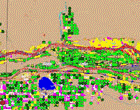CALMIT: Center for Advanced Land Management Information Technologies
Date of this Version
2006
Citation
Geophys. Res. Lett., 33, L06603, doi:10.1029/2005GL025056
Abstract
Percent reflectance of corals is perhaps the most important remotely sensed data that can be related to their biophysical properties. Because most of the biophysical variables of corals (i.e., pigment content, live cover and algal overgrowth) are related to their reflectance spectra, the analysis and inversion of the spectra may provide an account of these variables. Our research was aimed at determining the relationship between the percent live cover and reflectance of corals. Two wavelength bands (405–425 nm, and 590–600 nm) were identified to establish the relationship. A linear relationship was observed, which showed higher correlation (R2 = 0.886) at 405–425 nm when compared to 590–600 nm (R2 = 0.602). Validation methods revealed that 405–425 nm wavelength range provided a better relationship than 590–600 nm in predicting percent live cover of corals.


Comments
Copyright 2006 by the American Geophysical Union.